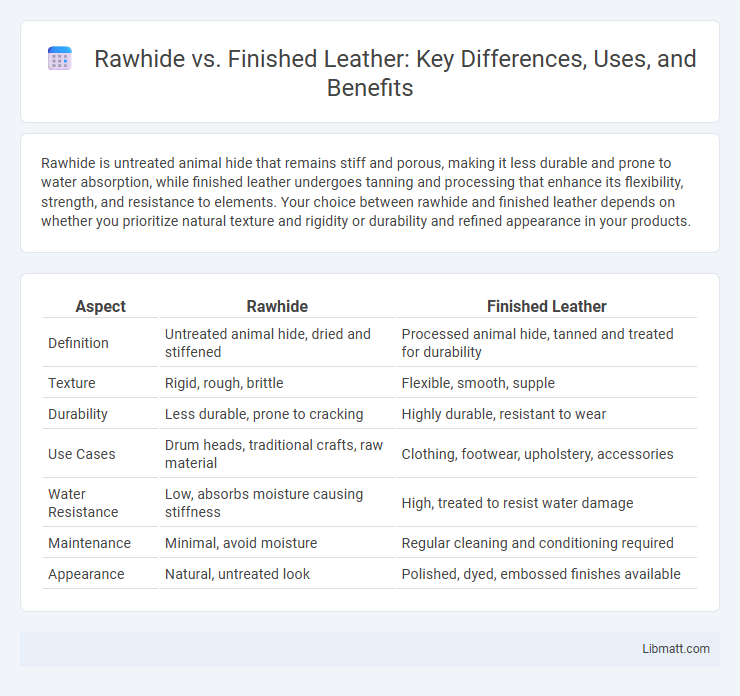Rawhide is untreated animal hide that remains stiff and porous, making it less durable and prone to water absorption, while finished leather undergoes tanning and processing that enhance its flexibility, strength, and resistance to elements. Your choice between rawhide and finished leather depends on whether you prioritize natural texture and rigidity or durability and refined appearance in your products.
Table of Comparison
| Aspect | Rawhide | Finished Leather |
|---|---|---|
| Definition | Untreated animal hide, dried and stiffened | Processed animal hide, tanned and treated for durability |
| Texture | Rigid, rough, brittle | Flexible, smooth, supple |
| Durability | Less durable, prone to cracking | Highly durable, resistant to wear |
| Use Cases | Drum heads, traditional crafts, raw material | Clothing, footwear, upholstery, accessories |
| Water Resistance | Low, absorbs moisture causing stiffness | High, treated to resist water damage |
| Maintenance | Minimal, avoid moisture | Regular cleaning and conditioning required |
| Appearance | Natural, untreated look | Polished, dyed, embossed finishes available |
Introduction to Rawhide and Finished Leather
Rawhide is the untreated, dried hide of an animal, retaining its natural toughness and rigidity, making it ideal for crafts like drum heads and traditional laces. Finished leather undergoes extensive processing, including tanning, dyeing, and sealing, resulting in a softer, more durable, and flexible material suitable for fashion and upholstery. Understanding the distinction between rawhide and finished leather helps you choose the right material for your project's durability and aesthetic needs.
Understanding Rawhide: Definition and Characteristics
Rawhide is untreated animal skin that remains stiff, porous, and highly absorbent due to the absence of tanning processes. Its natural characteristics include rigidity when dry and flexibility upon moistening, making it ideal for crafts like drum heads and traditional coverings. Understanding these properties helps you appreciate the functional differences rawhide offers compared to finished leather.
Finished Leather: Types and Features
Finished leather encompasses various types, including aniline, semi-aniline, and pigmented leather, each distinguished by its surface treatment and durability. Aniline leather retains a natural look with minimal coating, providing softness and breathability, while semi-aniline offers a slight protective finish enhancing resistance to stains and fading. Pigmented leather features a durable topcoat, making it highly resistant to wear and suitable for high-traffic use, ensuring your leather products maintain their appearance with ease.
Rawhide Production Process
Rawhide production involves soaking animal hides in water, followed by the removal of hair and flesh without tanning, which preserves the natural toughness and rigidity of the material. Unlike finished leather, rawhide undergoes a drying process that hardens the hide, making it stiff and durable but less flexible and breathable. This transformation is crucial for applications requiring a firm, resilient surface, such as drumheads or traditional whip handles.
How Finished Leather Is Made
Finished leather is produced through a comprehensive tanning process that transforms rawhide into a durable, flexible material suitable for various applications. The process typically involves soaking, cleaning, tanning with chrome or vegetable solutions, dyeing, and applying finishing coatings such as pigments or protective sealants. These treatments enhance the leather's appearance, water resistance, and texture, making it ideal for fashion, upholstery, and accessories.
Key Differences Between Rawhide and Finished Leather
Rawhide is untreated animal hide that is dried and stiff, while finished leather undergoes tanning, dyeing, and conditioning processes to enhance durability and flexibility. Rawhide retains a rough, porous surface making it less water-resistant compared to finished leather's smooth, polished texture that offers better protection and aesthetic appeal. Finished leather is more suitable for products requiring softness and longevity, whereas rawhide is often used in applications demanding rigidity, such as drum heads or dog chews.
Durability and Flexibility Comparison
Rawhide offers exceptional durability due to its untreated, dense fiber structure, making it highly resistant to tearing and wear in heavy-duty applications. Finished leather provides greater flexibility and comfort, as tanning and finishing processes soften the material, allowing it to mold more easily to shapes and movements. Your choice depends on whether you prioritize rawhide's rugged strength or finished leather's adaptable resilience for your specific use.
Common Uses of Rawhide vs. Finished Leather
Rawhide is commonly used in crafting durable items like drum heads, dog chews, and traditional moccasins due to its stiff and untreated nature. Finished leather, treated and polished for durability and aesthetic appeal, is preferred for fashion accessories, upholstery, footwear, and automotive interiors. The distinct textures and flexibility of finished leather make it ideal for garments and high-end goods, whereas rawhide's rigidity suits rugged, utilitarian products.
Pros and Cons of Rawhide and Finished Leather
Rawhide offers exceptional durability and a natural, rugged texture ideal for heavy-duty items but tends to be stiffer and less water-resistant than finished leather. Finished leather provides a smooth, polished look with enhanced flexibility and water resistance due to tanning and coating processes, making it more comfortable for garments and accessories. Your choice depends on whether you prioritize raw strength and natural feel with rawhide or refined appearance and versatility with finished leather.
Choosing the Right Material for Your Needs
Rawhide offers a stiff, durable texture that is ideal for crafting items requiring rigidity, such as drum covers or protective gear, while finished leather provides a softer, more flexible option suited for apparel, upholstery, or accessories. Your choice depends on the intended use and desired durability; rawhide resists wear and moisture better but is less comfortable, whereas finished leather offers enhanced aesthetics and comfort through tanning and finishing processes. Understanding these differences helps you select the right material to meet both functional and stylistic needs effectively.
Rawhide vs finished leather Infographic

 libmatt.com
libmatt.com